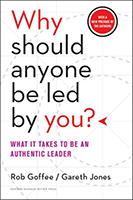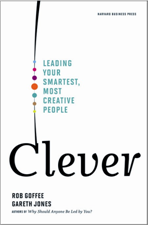What we say...
-
3 Critical Skills to Teach in Leadership Training
Sunday 1st September 2019
-
Leadership, Change and Uncertainty
Friday 6th April 2018
-
What does the Oxfam scandal tell us about organisations
Friday 23rd February 2018
-
I look forward to speaking at The HR Congress
Tuesday 31st October 2017
-
Why should anyone work here - Animation
Friday 11th December 2015
The Organization of Your Dreams
We have known for about 150 years that people who enjoy their work are more productive. That is to say high satisfaction is correlated with high performance. And yet many organizations seem to go out of their way to make work alienating, frustrating, and unpleasant. This is evidenced in the depressingly low rates of employee engagement around the world. According to a recent AON Hewitt survey, four in 10 workers on average report being disengaged worldwide (three out of 10 in Latin America, four in ten in the U.S., and five in 10 Europe)
This finding resonates with our latest research. For more than four years now, we have been asking people what an “authentic” organization would be like – that is, one in which they could be their best selves. While individual answers vary, of course, we consistently find that they fall into six broad imperatives, which describe what we call ”The organization of your DREAMS,” a handy mnemonic, whose components are:
Difference – “I want to work in a place where I can be myself.”
Radical honesty – “I want to know what’s really going on.”
Extra value – “I want to work in an organization that makes me more valuable.”
Authenticity – “I want to work in an organization that truly stands for something.”
Meaning – “I want my day-to-day work to be meaningful.”
Simple rules – “I do not want to be hindered by stupid rules.”
This may seem obvious. Who would want to work in the opposite kind of place — an organization where conformity is enforced, where employees are the last to know the truth, where people feel exploited rather than enriched, where values change with the seasons, where work is alienating and stressful, and where a miasma of bureaucratic rules limits human creativity and effectiveness? That’s the organization of your nightmares, not your dreams!
And yet we find that few organizations fulfill all the elements of this dream workplace.
Why? Our research indicates that many tackle these issues (and it’s not like they’re not trying to) far too superficially. They apply sticking plaster or Band-Aids to problems when they arise and seem unprepared to tackle fundamental underlying issues. What issues are these?
Let’s begin with Difference. For many organizations, accommodating differences translates into a concern with diversity, usually defined according to the traditional categories of gender, race, age, religion, and so on. These are, of course, of tremendous importance, but the executives in our research were after something subtler and harder to achieve – an organization that can accommodate differences in perspective, habits of mind, core assumptions, and worldviews. Indeed, these executives have actually become resistant to the conventional diversity agenda. We were recently in an organization that had produced a 142-page booklet called “Managing Diversity.” (We wonder how many people will actually read it.) And yet in all those pages, the crucial argument that creativity (a key index of performance) increases with diversity and declines with conformity is never really made.
What about Radical Honesty? Organizations are increasingly recognizing the importance of communications – both internally and to wider stakeholders. One key indication of this is that we are now finding communications professionals at or near the summit of organizations. This is a step in the right direction, for we have all learned that reputational capital is becoming more and more important for high performance — and at the same time increasingly fragile. Think of Arthur Andersen, arguably the greatest professional services organization in the world, which ceased to exist within a month after the Enron scandal. Still, the growth of the communications profession is actually more evidence that companies are taking a superficial approach to the dissemination of critical information – the kind high performers need to do their jobs. The mind-set of so many communications professionals remains stubbornly connected to an old world in which information is power and spin is their key skill. Surely information is power, but companies need to acknowledge that they no longer have control of it. In a world of WikiLeaks, whistle blowing, and freedom of information their imperative should be to tell the truth before someone else does.
How can organizations create Extra Value? Elite organizations and professions — the McKinseys, Johns Hopkins Hospitals, and PwCs of this world – have been in the business of making great people even better for a long time now. Part of their pact with employees is “Join us and we will develop you.” But they deal with only a tiny proportion of the workforce. What about the rest of us? Our research shows that high performance arises when individuals all over the organization feel they can grow through their work — adding value as the organization adds value to them. And that means the administrative assistants and cashiers, as well as the executives and the shift managers. This is not impossible – if a company like McDonald’s U.K. finds it profitable to train the equivalent of six full classes of students every week to attain formal qualifications in math and English, surely other companies can do more.
What does it mean for an organization to be Authentic? This is a big question. We have developed three markers of authenticity. First, a company’s identity is consistently rooted in its history. Second, employees demonstrate the values the company espouses. And third, company leaders are themselves authentic. This is clearly not simple to achieve. Sadly, rather than rise to the challenge, in many organizations the task of building authenticity has collapsed into the industry of mission-statement writing. People we’ve interviewed despair as they tell us of mission statements rewritten for the fourth time in three years! Not surprisingly, this produces not high performance but deep-rooted cynicism.
The search for Meaning in work is not new. There are libraries full of research on how jobs may produce a sense of meaning – and how they can be redesigned in ways that produce “engagement.” But meaning in work is derived from a wider set of issues than those narrowly related to individual occupations. It also emerges from what we have called the three C’s – connections, community, and cause. Employees need to know how their work connects to others’ work (and here, too often, silos get in the way). They need a workplace that promotes a sense of belonging (which is increasingly difficult in a mobile world). And they need to know how their work contributes to a longer term goal (problematic, when shareholders demand quarterly reporting). If these issues are not addressed, engagement efforts will have only fleeting effects.
Finally, the organization of your dreams has Simple — and agreed upon — Rules. Many organizations display a form of rule accretion, where one set of bureaucratic instructions begets another, which seeks to address the problems created by the first set. In response to this, organizations have attempted a kind of radical delayering. This has at least addressed the problem of losing ideas and initiatives in a byzantine hierarchical structure. But that, too, is only a superficial fix. The company of our dreams is not a company without rules – it is a company with clear rules that make sense to the people who follow them, a much larger challenge, with a far greater payoff.
We used to think that high-performance organizations had “strong” cultures within which individuals did or did not fit. But the paradigm has flipped. In the new world, organizations must increasingly adapt to the individuals they wish to engage. This is at the core of the organization of your dreams. Sustained high performance requires nothing less than a reinvention of the habitual patterns and processes of organizations.
Credit: Harvard Business Review



